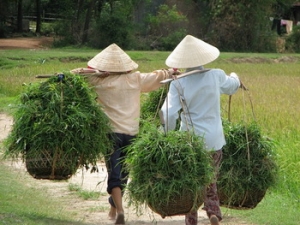Dairy farming

Last week, AlertNet published an opinion piece highlighting recent research by the International Centre for Tropical Agriculture (CIAT) on how forage-based systems, which dominate agriculture in the tropics, could be harnessed to reduce livestock’s contribution to climate change.
‘Livestock have particularly been ‘lambasted for their voluminous greenhouse gas emissions, implicated in massive land degradation, and denounced for driving deforestation, [and] are supposedly the bad kids on the block – the black sheep of sustainable agriculture. The polarisation of the livestock debate has brought about one of the greatest public image travesties of our time. It has seen small-scale livestock keepers, who raise a handful of animals for milk or meat in low-tech systems with a negligible environmental footprint, tarred with the same brush as large-scale industrial producers.’
The article cites recently published research by CIAT, which shows that ‘well-managed “LivestockPlus” systems involving improved forage crops – plants grazed by livestock – actually have impressive environmental credentials.’
The findings are based research that looked at the use of a forage known as brachiaria, a deep-rooted grass native to Africa that is now widely grown in South America and in Southeast Asia; which shows that ‘improved forage crops’ have multiple benefits for sustainable smallholder agriculture and could be powerful crops for mitigating climate change as well as helping restore degraded pastures.
‘With its big green leaves, brachiaria has very high carbon accumulation potential, acting as a powerful carbon sink within livestock systems. It can also help retain and even increase stocks of soil carbon, in part by recycling carbon through animal manure and aboveground litter, and also due to its high turnover of roots – each generation of roots adds to the carbon stock deep in the soil.
‘In fact, the CIAT study shows that high quality forages like brachiaria are second only to native forest in terms of their potential for storing soil carbon. In areas with high rainfall, they could even sequester more atmospheric CO2 than forests. Forthcoming research will look more closely at this.
This latest research was published in CIAT’s new flagship publication Eco-Efficiency: From Vision to Reality, which details the science of sustainable smallholder agriculture.
‘Brachiaria has been shown to produce higher milk and meat yields in cattle – ten times more per unit land area than if the animals grazed on native savanna grass. And because it’s a high quality, easily digestible food, animals fed with brachiaria emit less methane per kilo of meat produced.’
‘With the right policy environment, higher productivity could also reduce the need for larger herds, in turn easing pressure on forests.’ The CIAT study recommends using brachiaria in “agro-silvo-pastoral systems”, or systems that incorporate an eco-efficient holy trinity of food crops, forages and trees.
According to article, ‘the solution [to the negative perception of livestock’s impact on the environment] could lie with the developing world’s 1 billion smallholder livestock keepers, who have much to gain from highly-productive LivestockPlus systems. Their involvement could be instrumental in helping to reversing livestock’s negative image, particularly if adoption of these systems means they become recognised as environmental guardians.’





















